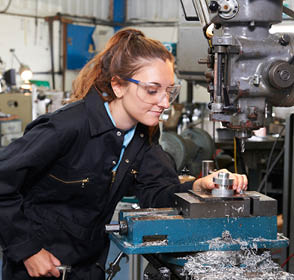
Can you students name a female engineer? Do they know what types of jobs engineers do?
On 23 June, schools across the country have the opportunity to raise the profile of girls in engineering and help their students to answer those two important questions! It’s National Women in Engineering Day, a day set up by the Women’s Engineering Society (WES) to focus attention on the great opportunities available for women in engineering.
Anyone can take part in the day, with events happening across the country and free resources available from the National Women in Engineering Day website. Take a look at what is happening in your local area, or use the free resource pack to host an event of your own. Why not invite an engineering employer to come and speak to your students or run a session in your school through STEM Ambassadors?
One of the female engineers that I will be celebrating on the 23 June is Beatrice ‘Tilly’ Shilling OBE PhD MSc CEng (1909 – 1990). In 1924, Beatrice Shilling in her mid-teens decided she wanted to be an engineer.
Beatrice became an apprentice in an electrical engineering company run by Margaret Partridge, who was involved with the Women’s Engineering Society. It was Margaret who persuaded Beatrice to apply for an engineering degree and with the support of the WES and she was one of just two pioneering female undergraduates on the Manchester University Electrical Engineering course in 1929.
After her degree at Manchester, she completed an MSc in Mechanical Engineering and took up motorcycle racing with the university club, using her engineering skills to keep her bike in racing condition. She carried out research at Birmingham University into supercharged single-cylinder engines until joining the Royal Aircraft Establishment (RAE) in 1936, where she became their leading specialist in aircraft carburettors.
Outside of work, she began racing at the Brooklands track with a Norton M30 500 cc motorcycle, adding a supercharger and lapping the Brooklands track at 106 mph in 1934. She was recognised by being awarded the Brooklands Gold Star for outstanding performances in track and road racing.
At the beginning of the Second World War, it became clear that there was a serious problem with the carburettors of Rolls-Royce Merlin-engine fighters, such as the Spitfire and the Hurricane. They would cut out when subjected to negative-g, such as when a fighter nosed over into a dive. German fighters were able to out manoeuvre the Royal Air Force (RAF) fighters and a solution needed to be found.
Beatrice devised the RAE restrictor, a small metal disc with a hole in the middle, fitted into the engine's carburettor. It restricted and regulated the fuel flow, allowing the RAF to match the manoeuvrability of the Luftwaffe fighters. She toured airfields fitting the device and was respected and held in affection by RAF pilots, for whom she worked to improve the device for the next 2 years.
After the war she continued to work with the RAE until her retirement in the 1960s. She received an OBE for her work and a doctorate from Surrey University and remained fascinated by racing, both bikes and cars, until she was forced to stop due to old age. She died in 1990.
Beatrice deserves to be remembered for not only being a pioneer in female engineering expectations but also for being a superb engineer.
